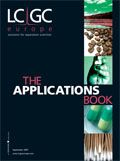Biodiesel Analyser Determines the Quality of Fatty Acid Methyl Esters (FAME) Blending Stock for Diesel Fuel
The Application Notebook
AC Analytical Controls developed a new chromatographic solution that complies with all ASTM & EN chromatographic test methods listed in biodiesel specifications: the AC all-in-one Biodiesel analyser. Analysis results demonstrate that the AC analyser complies with EN 14103, EN 14105, EN 14106, EN 14110 & ASTM D6584 methods.
In the last decade there has been a worldwide growth in the interest for alternative fuels. Biodiesel, fatty acid methyl esters (FAMEs), offers an alternative to fossil diesel fuel and contributes to the reduction of greenhouse gas emissions. FAME can be blended with petroleum diesel (mostly 5% = B5) or used as pure biodiesel (B100). FAME as a blending component for fuels needs to comply with the fuel specifications EN 14214 or ASTM D6751.
The presence of free glycerol and glycerides in FAME used as diesel fuel may lead to injector deposits, clogged fueling systems, filter plugging, and adversely effect cold weather operation. Linolenic and poly-unsaturated esters display a strong effect on oxidative stability of the FAME.
Biodiesel Analysis Solution
AC Analytical Controls developed a new chromatographic solution that complies with all ASTM & EN chromatographic test methods for biodiesel analysis: the AC all-in-one Biodiesel analyser.
System Description
The AC all-in-one Biodiesel system uses the new Agilent Technologies 7890 gas chromatograph equipped with two capillary columns, one split/splitless inlet, one on-column inlet, two flame ionization detectors (FID) for signal generation, one additional column oven module, one automatic liquid sampler (optional), one headspace sampler (optional).
Analysis
Experimental conditions are according or in compliance with the individual methods.
ASTM D6584 and EN 14105: 1 μL of sample is analysed after silyating with N-methyl-N-trimethylsilyl-trifluoracetamide (MSTFA). Both methods use the same internal standard components and multilevel calibration curves to quantify the glycerol and glycerides (mono-, di- and triolein).
EN 14103: Ester content and linolenic acid methyl ester content are quantified by internal calibration with methyl heptadecanoate.
EN 14106: Liquid-liquid extraction is used to separate the free glycerol and the internal standard (1,4-butanediol) from the FAME. The extract is analysed by the system to determine the free glycerol content.
EN 14110: The mean of the calibration factors from the three described reference solutions is used for the calculation using the internal calibration procedure described in the method.

Table 1: All-in-one biodiesel test methods.
Analysis Results
Free and Total glycerin (free + bound glycerin) can be reported according to ASTM D6584 and EN 14105. Small differences between the methods are observed. This is because of the differences in conversion factors used for the calculation of the bonded glycerin content by the two methods.
Conclusion
The all-in-one biodiesel solution complies with all mentioned test methods.
EN 14106 quickly determines the free glycerol content in FAME based upon a single level calibration. This free glycerol content is also determined by EN 14105 and ASTM D6584. However, these methods require more labour intensive sample preparation, multilevel calibration and a longer analysis time.
When analysing only a small number of samples, the internal calibration method as described in EN 14110 is preferred. Optional headspace equipment allows for automated analysis using external calibration.
Vincent Otten, AC Analytical Controls, Rotterdam, The Netherlands.

AC Analytical Controls
Innsbruckweg 35, 3047 AG Rotterdam, the Netherlands
tel. +31 10 462 4811 fax +31 10 462 6330
E-mail: acbv@analytical-controls.com
Website: www.analytical-controls.com

University of Rouen-Normandy Scientists Explore Eco-Friendly Sampling Approach for GC-HRMS
April 17th 2025Root exudates—substances secreted by living plant roots—are challenging to sample, as they are typically extracted using artificial devices and can vary widely in both quantity and composition across plant species.
Sorbonne Researchers Develop Miniaturized GC Detector for VOC Analysis
April 16th 2025A team of scientists from the Paris university developed and optimized MAVERIC, a miniaturized and autonomous gas chromatography (GC) system coupled to a nano-gravimetric detector (NGD) based on a NEMS (nano-electromechanical-system) resonator.
Miniaturized GC–MS Method for BVOC Analysis of Spanish Trees
April 16th 2025University of Valladolid scientists used a miniaturized method for analyzing biogenic volatile organic compounds (BVOCs) emitted by tree species, using headspace solid-phase microextraction coupled with gas chromatography and quadrupole time-of-flight mass spectrometry (HS-SPME-GC–QTOF-MS) has been developed.











